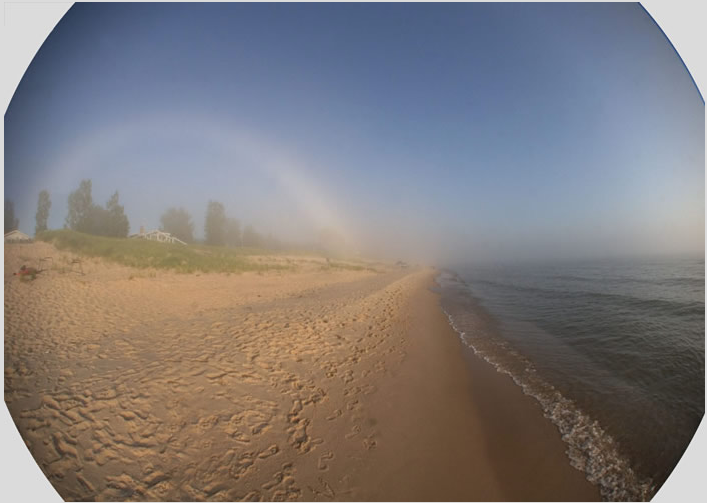Lake Michigan fogbow
Lake Michigan Fogbow: A Spectacular Atmospheric Phenomenon
The Lake Michigan fogbow is a captivating atmospheric optics phenomenon that occurs when fog is present over the lake. It is a rare and mesmerizing sight that leaves onlookers in awe. Similar to a rainbow, the fogbow forms due to the interaction of sunlight with water droplets in the air. However, there are some distinct differences that make the Lake Michigan fogbow truly unique.
What is a Fogbow?
A fogbow, also known as a white rainbow, is a colorless or faintly colored arc that appears in foggy conditions. Unlike a traditional rainbow, which forms from raindrops, a fogbow forms from the smaller water droplets found in fog. These tiny droplets scatter and diffract light, creating a diffused appearance with muted colors.
The Science Behind the Lake Michigan Fogbow
The formation of a fogbow begins with the presence of fog over Lake Michigan. As sunlight passes through the fog, it encounters the tiny water droplets suspended in the air. These droplets act as tiny prisms, bending and scattering the sunlight. The bending of light causes it to separate into its component colors, similar to how a prism disperses white light into a spectrum.
Characteristics of the Lake Michigan Fogbow
The Lake Michigan fogbow has some unique characteristics that set it apart from other fogbows. Here are some key features of this captivating phenomenon:
-
Colorless Appearance: Unlike a traditional rainbow, the Lake Michigan fogbow appears colorless or with very faint colors. This is due to the smaller size of the water droplets in fog, which diffract light differently than raindrops.
-
Large Size: The Lake Michigan fogbow can span a wide arc across the sky, often reaching up to 180 degrees. Its expansive size adds to its grandeur and makes it an impressive sight to behold.
-
Fainter Outer Edge: The outer edge of the fogbow is usually fainter compared to the inner edge. This creates a subtle halo effect around the arc, enhancing its ethereal appearance.
-
Absence of Supernumerary Bows: Unlike some rainbows that display additional faint arcs known as supernumerary bows, the Lake Michigan fogbow typically lacks these secondary features. This further adds to its distinctiveness.
Optimal Viewing Conditions
To witness the breathtaking beauty of the Lake Michigan fogbow, specific conditions need to align:
-
Foggy Weather: The presence of fog is essential for the formation of a fogbow. The thicker the fog, the more pronounced and visible the fogbow will be.
-
Sunlight: Adequate sunlight is necessary for the fogbow to appear. A break in the clouds or a clearing in the fog allows sunlight to penetrate and interact with the water droplets.
-
Proper Viewing Angle: To fully appreciate the Lake Michigan fogbow, it is best observed when facing away from the sun. This ensures that the sunlight is coming from behind, illuminating the fog and creating the optimal conditions for the fogbow to manifest.
The Magic of Lake Michigan Fogbows
Lake Michigan fogbows are a captivating natural phenomenon that showcases the beauty and complexity of atmospheric optics. As sunlight interacts with the tiny water droplets in fog, it creates a mesmerizing colorless or faintly colored arc across the sky. The large size and ethereal appearance of the Lake Michigan fogbow make it a truly enchanting sight.
Capturing the Beauty: Photography Tips
If you are fortunate enough to witness a Lake Michigan fogbow, capturing its beauty through photography can be a rewarding experience. Here are some tips to help you capture the essence of this elusive phenomenon:
-
Use a Wide-Angle Lens: A wide-angle lens allows you to capture the full arc of the fogbow, showcasing its grandeur and expansive size.
-
Adjust Exposure: Experiment with different exposure settings to capture the subtle colors and details of the fogbow. Bracketing your shots can help ensure you capture the optimal exposure.
-
Consider Composition: Incorporate interesting elements in your composition, such as the lake, trees, or other natural surroundings, to add depth and context to your photographs.
-
Be Patient: Lake Michigan fogbows are rare occurrences, so be patient and ready to capture the moment when it presents itself. Keep an eye on weather conditions and be prepared to venture out in foggy weather for the best chances of witnessing this atmospheric marvel.
Conclusion
The Lake Michigan fogbow is a captivating atmospheric phenomenon that showcases the interplay between sunlight and water droplets in foggy conditions. Its colorless or faintly colored arc spanning across the sky leaves spectators in awe of nature's wonders. The unique characteristics of the Lake Michigan fogbow, such as its large size and ethereal appearance, make it a truly enchanting sight. So, if you find yourself near Lake Michigan on a foggy day, keep your eyes peeled for the mesmerizing beauty of the Lake Michigan fogbow.

Lake Michigan fogbow imaged by Tom Polakis using a 180° field of view lens. Image ©Tom Polakis
Note: this article has been automatically converted from the old site and may not appear as intended. You can find the original article here.
Reference Atmospheric Optics
If you use any of the definitions, information, or data presented on Atmospheric Optics, please copy the link or reference below to properly credit us as the reference source. Thank you!
-
<a href="https://atoptics.co.uk/blog/lake-michigan-fogbow/">Lake Michigan fogbow</a>
-
"Lake Michigan fogbow". Atmospheric Optics. Accessed on November 26, 2024. https://atoptics.co.uk/blog/lake-michigan-fogbow/.
-
"Lake Michigan fogbow". Atmospheric Optics, https://atoptics.co.uk/blog/lake-michigan-fogbow/. Accessed 26 November, 2024
-
Lake Michigan fogbow. Atmospheric Optics. Retrieved from https://atoptics.co.uk/blog/lake-michigan-fogbow/.